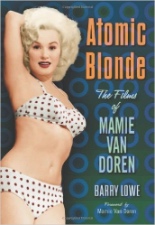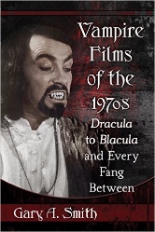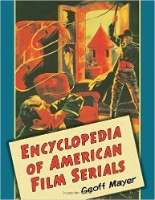 Does the world need more than one book on the movies of Mamie Van Doren? Hell, no. But I sure do! With Joseph Fusco’s 2010 book already sitting on my shelf, now there’s Atomic Blonde: The Films of Mamie Van Doren to keep it company. First published in 2008, Barry Lowe’s book now is back in print and available in a more affordable paperback edition from McFarland. Today a prolific author of gay erotica, Lowe spends the first 50-ish pages to deliver a condensed biography of the former Joan Olander, the virginal farm girl who became one of the three iconic sex bombs of the squeaky-clean 1950s and boundary-pushing ’60s, behind Marilyn Monroe and Jayne Mansfield. And the rest of the text? Why, a flick-by-flick examination of her career, of course, with special attention given to her campier efforts — including High School Confidential!, Sex Kittens Go to College, Las Vegas Hillbillys, The Navy vs. the Night Monsters, Voyage to the Planet of the Prehistoric Women — and no punches pulled. Lowe wrote this breezy book with the hopes that readers might see her as skilled beyond testing the thread strength of sweaters, and yet it is populated with photos that play up those God-given talents. In my eyes, that’s not really a complaint. Recommended!
Does the world need more than one book on the movies of Mamie Van Doren? Hell, no. But I sure do! With Joseph Fusco’s 2010 book already sitting on my shelf, now there’s Atomic Blonde: The Films of Mamie Van Doren to keep it company. First published in 2008, Barry Lowe’s book now is back in print and available in a more affordable paperback edition from McFarland. Today a prolific author of gay erotica, Lowe spends the first 50-ish pages to deliver a condensed biography of the former Joan Olander, the virginal farm girl who became one of the three iconic sex bombs of the squeaky-clean 1950s and boundary-pushing ’60s, behind Marilyn Monroe and Jayne Mansfield. And the rest of the text? Why, a flick-by-flick examination of her career, of course, with special attention given to her campier efforts — including High School Confidential!, Sex Kittens Go to College, Las Vegas Hillbillys, The Navy vs. the Night Monsters, Voyage to the Planet of the Prehistoric Women — and no punches pulled. Lowe wrote this breezy book with the hopes that readers might see her as skilled beyond testing the thread strength of sweaters, and yet it is populated with photos that play up those God-given talents. In my eyes, that’s not really a complaint. Recommended!
 Maybe having been born in 1971 has something to do it, but I think some of the most memorable vampire movies came from that decade. (I mean, seriously, The Vampire Happening? The Vampires Night Orgy? The Dracula Saga? C’mon, folks!) Gary A. Smith agrees; as he writes in the introduction of Vampire Films of the 1970s: Dracula to Blacula and Every Fang Between, “filmmakers everywhere jumped on the bloody bandwagon,” giving us bloodsuckers that also were black, gay, adept at kung fu, peace-preaching and puppies — just not all at once. The fun of this McFarland & Company paperback is in Smith covering their respective flicks not chronologically, but broken up into distinct groups, such as “Carmilla” adaptations, Jean Rollin works, Mexican entries, outright comedies and, yep, “Vampire Porn.” Any book that gives the likes of Al Adamson, Andy Milligan and Jess Franco chapters of their own is one worth sinking your teeth into.
Maybe having been born in 1971 has something to do it, but I think some of the most memorable vampire movies came from that decade. (I mean, seriously, The Vampire Happening? The Vampires Night Orgy? The Dracula Saga? C’mon, folks!) Gary A. Smith agrees; as he writes in the introduction of Vampire Films of the 1970s: Dracula to Blacula and Every Fang Between, “filmmakers everywhere jumped on the bloody bandwagon,” giving us bloodsuckers that also were black, gay, adept at kung fu, peace-preaching and puppies — just not all at once. The fun of this McFarland & Company paperback is in Smith covering their respective flicks not chronologically, but broken up into distinct groups, such as “Carmilla” adaptations, Jean Rollin works, Mexican entries, outright comedies and, yep, “Vampire Porn.” Any book that gives the likes of Al Adamson, Andy Milligan and Jess Franco chapters of their own is one worth sinking your teeth into.
 One area of the movies I have yet to take a deep dive into? Ye olde serials. Other than chapters of Bela Lugosi in The Corpse Vanishes doled out across several early episodes of Mystery Science Theater 3000, these superheroic, swashbuckling, space-patroling, spy-smashing tales remain a blind spot in my cinematic education. Because they are extinct, I’m guessing the same may be true for many of you. For a crash course, turn to Geoff Mayer’s Encyclopedia of American Film Serials. Designed by McFarland & Company as an oversized paperback, it seems ready-made for decades of referencing to come. It holds tremendous value in that it’s indexed not only by titles, but actors, directors, writers — heck, even composers! Entries are written with voluminous knowledge, with particular attention paid to concepts and cliffhangers, but the introduction gives a broad, baseline knowledge of the art form, its various studios and its eventual death. The reproductions of poster art are entirely welcome; I just wish they were in color, although the shorts they shilled were not. —Rod Lott
One area of the movies I have yet to take a deep dive into? Ye olde serials. Other than chapters of Bela Lugosi in The Corpse Vanishes doled out across several early episodes of Mystery Science Theater 3000, these superheroic, swashbuckling, space-patroling, spy-smashing tales remain a blind spot in my cinematic education. Because they are extinct, I’m guessing the same may be true for many of you. For a crash course, turn to Geoff Mayer’s Encyclopedia of American Film Serials. Designed by McFarland & Company as an oversized paperback, it seems ready-made for decades of referencing to come. It holds tremendous value in that it’s indexed not only by titles, but actors, directors, writers — heck, even composers! Entries are written with voluminous knowledge, with particular attention paid to concepts and cliffhangers, but the introduction gives a broad, baseline knowledge of the art form, its various studios and its eventual death. The reproductions of poster art are entirely welcome; I just wish they were in color, although the shorts they shilled were not. —Rod Lott
